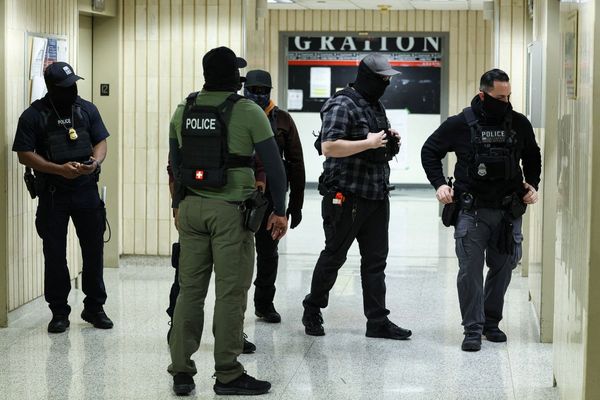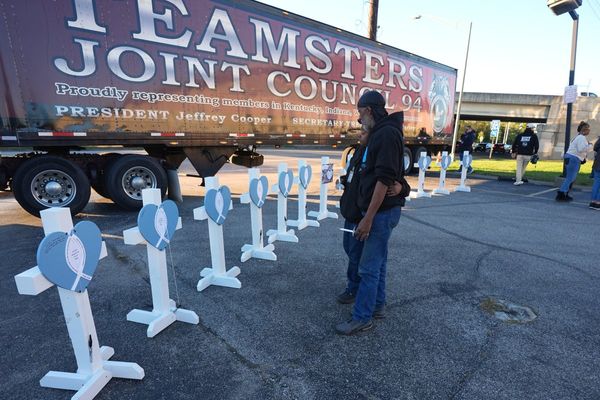
When she remembers the corpses on the asphalt, the bodies of her neighbours and of the boy who used to play with her children, Lemlen Abraha breaks down in tears.
“They just shot him,” she says of 14-year-old Kalayu Mebrahtom, killed by government soldiers in the first weeks of Ethiopia’s civil war and left to be buried by his grandmother. “I’d left my home to buy sugar – I saw it on the street, I saw it with my own eyes.”
Since the war began two years ago, Lemlen has been living in a refugee camp in Sudan with two of her teenage children, and four others whose parents are missing.
Lemlen’s six-year-old daughter, Hiyab, and her husband, Fisseha – are still lost, separated in the chaos. When the Guardian met Lemlen in early December, weeks after a peace deal ostensibly had ended the war, she didn’t know if they were alive or dead. She still doesn’t.
A fragile peace process in Ethiopia’s Tigray region, where war has left an estimated more than half a million dead, is beginning to show dividends, raising hopes for a end to a conflict that counts ethnic cleansing and human-made famine among its horrors.
Yet in Sudan, near the border of Ethiopia and the disputed territory of what is officially called western Tigray, tens of thousands of refugees remain in limbo – unable, or too afraid, to return home.
Refugees – mostly ethnic Tigrayans from the Wolkait district of western Tigray, but also some from smaller ethnic groups such as the Kemant, Kunama and Irob – told the Guardian their land was still occupied by armed forces from Ethiopia’s Amhara region or, in some cases, allied troops from neighbouring Eritrea.
Lemlen had found a piece of paper pinned to her door in the town of Baeker in western Tigray. Scrawled on it was a threat: all Tigrayans must leave the town or face the consequences. She reached Sudan in November 2020.
She says she has heard from her former neighbours in Amhara that her home has been occupied by newcomers, who have also started working her family’s plot of land.

Human rights groups have described these patterns of dispossession and violence as ethnic cleansing. According to Amnesty and Human Rights Watch, Amhara militia and volunteer fighters known as Fanos, established Amhara government administration over the fertile agricultural territory between late 2020 and 2022. Hundreds of thousands of Tigrayans were expelled, and Amhara farmers resettled there.
If the international community protects the displaced people, Lemlen suggests, perhaps it would be safe for them to return. But she sees no imminent prospect of that.
The peace deal stated that the question of disputed territories – which include parts of south Tigray – should be settled through constitutional means, which may one day mean a referendum. But it set out no timeline.

Eritrean troops, who have been implicated in some of the war’s worst atrocities, pose another challenge. The peace deal, signed in South Africa by the government of prime minister Abiy Ahmed and Tigray’s leaders – the Tigrayan People’s Liberation Front (TPLF) – made no mention of the Eritreans. But an implementation roadmap signed a few days later in Kenya specified that the gradual disarmament of Tigray’s forces would take place alongside the “withdrawal of foreign and non-ENDF (federal military) forces from the region”.
In recent days, there have been reports of Eritrean troops withdrawing from some towns in Tigray. But as recently as December, according to minutes seen by the Guardian from a meeting of the Tigray Emergency Coordination Centre, a hub of UN agencies and NGOs, Eritrean troops continued to loot, kill, kidnap and rape. One refugee with relatives living near the town of Adwa told the Guardian his young cousin was killed by Eritrean forces in a nearby village in mid-December.
“Until Eritrea leaves, there will be no peace,” says Solomon, a Tigrayan teacher who fled Humera, a city near the Sudan and Eritrea borders, at the start of the war. On rare occasions when he has been able to reach friends and family in western Tigray, they have said the same thing – that until at least mid-December, Eritrean troops were stationed along key highways and migration routes, including those leading to Sudan. Aid workers confirmed these accounts, but it is unclear how many Eritrean troops remain today.
Elsewhere in Tigray, food aid and medical supplies have been trickling in since November, staving off the worst of starvation. Phone lines and internet services, suspended during the war, are being switched back on sporadically, allowing communication with the outside world for the first time in many months. Mekelle has been reconnected to the national grid and partial banking services have resumed in some towns.
“In Mekelle, [the phone] network is working,” a Tigrayan in Kenya told the Guardian by text message on 29 December. “I spoke with my family, I think they are OK.”

On 28 December an Ethiopian Airlines plane touched down in Mekelle, the first commercial flight in 18 months, effectively lifting the ban on movement in place since June 2021. The next day, Ethiopian federal police arrived in Mekelle to guard federal government facilities, a visible return to normality.
However, there remains a climate of uncertainty. Excitement over restored phone lines, for example, is tempered by fears of surveillance. “If you call, you put people in danger,” says Abeba, a refugee who fled western Tigray at the start of the war. Three refugees said friends or family members had disappeared shortly after receiving phone calls from Sudan. “If they [security forces] see someone receive a call from a Sudan number, [they] will be arrested,” she says.
Insecurity prevails in Ethiopia; as war has wound down in Tigray, it has escalated in Oromia, the largest region, which has seen drone strikes on civilians and a string of gruesome inter-ethnic massacres. The Oromo Liberation Army (OLA), another armed group, is not part of the current peace deal. Nor are smaller ones linked to minorities such as the Gumuz, Agew or Kemant.
OLA fighters as well as Oromo security forces stand accused of killing civilians in Oromia; Amhara civilians continue to face indiscriminate violence in places where they are a minority. In recent months Amhara militias are also reported to have conducted raids and killings inside Oromia.
In the Amhara region meanwhile, violence continues against Kemant civilians by regional security forces and militias. Kemant refugees told the Guardian they would not return without security assurance, as most of their lands are now occupied. Irob and Kunama refugees, whose smaller populations live close to Eritrea, want guarantees regarding Eritrean troops along the border with Ethiopia.
UN officials say the current peace should be seen as a starting point; an opportunity to build confidence among Ethiopians before seeking to address some of the more contentious issues around disputed territories.

There is recognition that this will take time. Emebet, a 23-year-old university student, has tried to stop daydreaming about going home. She learned from neighbours that her apartment in Humera, damaged by shelling at the start of the war, has been repaired and is being rented to newcomers.
In the straw hut she shares with her husband, Emebet has hung colourful drapes from the ceiling, trying to make the place homely. There is a small Sudanese flag in the corner of her makeshift kitchen – a tribute to the country that has offered them refuge.
“I’m scared to think about what Ethiopia will become,” says Emebet, referring to the deepening distrust between communities. She doubts whether refugees from western Tigray will ever return; if the peace holds, she thinks most of them will relocate elsewhere. “I don’t think we can ever go back.”







